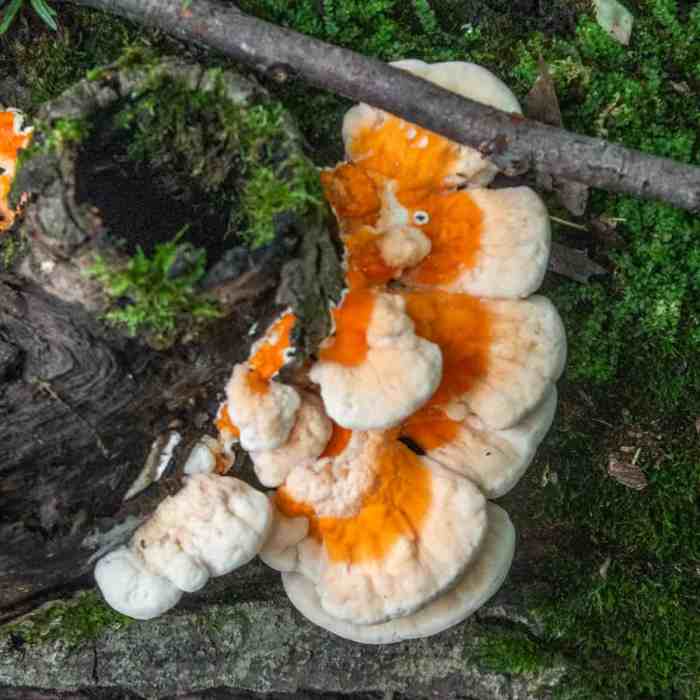
Dive into the captivating world of chicken of the woods recipe, where nature’s bounty meets culinary artistry. From its distinct flavors to its remarkable versatility, this edible mushroom promises an unforgettable gastronomic experience.
Chicken of the woods, with its vibrant hues and meaty texture, is a true delicacy that has captivated chefs and home cooks alike. Its versatility shines through in countless culinary creations, from savory soups and stews to mouthwatering pasta dishes and grilled delicacies.
Culinary Applications of Chicken of the Woods

Chicken of the woods is a versatile mushroom known for its distinct flavors and textures. Its meaty texture and mild, slightly sweet flavor make it a popular choice for culinary applications.
Another great way to prepare chicken of the woods is with this chicken of the woods recipe . This recipe calls for sautéing the mushrooms in butter and garlic, then adding them to a creamy sauce. Serve it over pasta or rice for a hearty and flavorful meal.
Cooking Methods
Chicken of the woods can be cooked in various ways, each highlighting its unique characteristics.
If you’re looking for a delicious and unique way to enjoy wild mushrooms, check out this chicken of the woods recipe . This fungus has a meaty texture and a slightly sweet flavor, making it a great substitute for chicken in many dishes.
- Sautéing:Sautéing chicken of the woods over medium heat with butter or olive oil enhances its earthy flavors. It can be seasoned with herbs, spices, or garlic for added depth.
- Roasting:Roasting chicken of the woods in the oven brings out its caramelized notes. Toss it with olive oil, salt, and pepper, and roast at 400°F for 20-25 minutes.
- Grilling:Grilling chicken of the woods over medium-high heat gives it a smoky, slightly charred flavor. Brush it with a marinade of soy sauce, honey, and sesame oil for an Asian-inspired twist.
Culinary Creations
Chicken of the woods’ versatility extends to a wide range of culinary creations.
- Soups and Stews:The meaty texture of chicken of the woods makes it an excellent addition to hearty soups and stews. Its mild flavor complements other ingredients without overpowering them.
- Pasta Dishes:Chicken of the woods pairs well with pasta, especially in creamy sauces or hearty marinara-based dishes. Its earthy flavors add depth and richness to the overall dish.
- Vegetarian Tacos:Chicken of the woods can be a satisfying meat substitute in vegetarian tacos. Sautéed with spices and seasonings, it mimics the texture and flavor of shredded chicken.
Health Benefits and Nutritional Value

Chicken of the woods is not just a culinary delight; it also boasts an impressive nutritional profile and potential health benefits. It is a rich source of vitamins, minerals, and antioxidants, making it a valuable addition to a healthy diet.
Nutritional Composition
- Vitamins:Chicken of the woods is a good source of vitamins B1, B2, B3, and D. These vitamins play vital roles in energy production, metabolism, and immune function.
- Minerals:It is rich in potassium, phosphorus, magnesium, and iron. Potassium supports blood pressure regulation, while phosphorus and magnesium are essential for bone health. Iron plays a crucial role in red blood cell production.
- Antioxidants:Chicken of the woods contains antioxidants like ergothioneine and glutathione. These antioxidants help protect cells from damage caused by free radicals, which can contribute to chronic diseases.
Potential Health Benefits
- Immune System Support:The vitamins and minerals in chicken of the woods, particularly vitamin D and beta-glucans, may help boost the immune system and protect against infections.
- Anti-inflammatory Properties:Studies have shown that chicken of the woods may possess anti-inflammatory properties, which could be beneficial for conditions like arthritis and inflammatory bowel disease.
Responsible Harvesting Practices
Chicken of the woods is a wild mushroom that should be harvested responsibly to ensure the sustainability of its populations. When foraging, it is important to:
- Only harvest mature mushrooms with fully developed gills.
- Cut the mushrooms at the base, leaving the mycelium intact.
- Harvest only a portion of the mushrooms found in an area, allowing others to mature and reproduce.
Identification and Foraging Techniques

Chicken of the woods ( Laetiporus sulphureus) is a vibrant and distinctive mushroom that can be easily identified in the wild. Here are some key characteristics to distinguish it from other similar-looking mushrooms:
- Color:Bright orange to yellow, fading to pale yellow with age.
- Shape:Shelf-like or bracket-shaped, with a wavy or lobed margin.
- Size:Can grow quite large, with caps up to 12 inches across.
- Flesh:White, firm, and meaty, with a mild, slightly fruity flavor.
Chicken of the woods is typically found in late summer and fall on dead or dying hardwood trees, particularly oak and maple. It prefers moist, shady areas, often near streams or in ravines.
Safety Precautions and Harvesting Guidelines
Before foraging for chicken of the woods, it is essential to take the following safety precautions:
- Always identify mushrooms with certainty:If you are not confident in your ability to identify mushrooms, it is best to avoid eating them.
- Harvest only from healthy trees:Do not collect mushrooms from trees that are diseased or dying.
- Cut the mushrooms cleanly:Use a sharp knife to cut the mushrooms from the tree, leaving no woody material behind.
- Cook mushrooms thoroughly:Chicken of the woods should be cooked thoroughly before eating to kill any potential pathogens.
Comparison with Other Edible Mushrooms: Chicken Of The Woods Recipe
Chicken of the woods holds its own among the esteemed ranks of edible mushrooms, boasting culinary qualities and nutritional value that rival its peers. In this section, we delve into a comparative analysis of chicken of the woods with other popular edible mushrooms, exploring their unique characteristics, flavor profiles, textures, and versatility.
Oyster Mushrooms
- Flavor and Texture:Oyster mushrooms possess a mild, earthy flavor and a tender, meaty texture that lends itself well to a variety of culinary applications.
- Nutritional Value:Rich in protein, fiber, and antioxidants, oyster mushrooms are a nutritious addition to any diet.
- Versatility:Oyster mushrooms can be sautéed, grilled, roasted, or added to soups and stews.
Shiitake Mushrooms
- Flavor and Texture:Shiitake mushrooms are known for their umami-rich flavor and firm, slightly chewy texture.
- Nutritional Value:A good source of protein, fiber, and vitamins B and D, shiitake mushrooms are a nutritional powerhouse.
- Versatility:Shiitake mushrooms are versatile ingredients that can be used in soups, stir-fries, sauces, and more.
Morels
- Flavor and Texture:Morels are highly prized for their nutty, earthy flavor and honeycomb-like texture.
- Nutritional Value:While not as nutrient-rich as other edible mushrooms, morels contain antioxidants and other beneficial compounds.
- Versatility:Morels can be sautéed, grilled, stuffed, or used in soups and stews.
Recipe Development and Culinary Inspiration

Chicken of the woods offers a versatile culinary canvas, inspiring a diverse range of recipes that showcase its unique flavors and textures. From hearty soups and stews to crispy fried bites and elegant entrees, the possibilities are endless. Let’s explore some tantalizing recipes that will ignite your creativity and inspire you to experiment with this extraordinary mushroom.
Soups and Stews
Chicken of the woods shines in hearty soups and stews, adding a meaty umami depth to the broth. Try simmering it in a rich vegetable broth with aromatic vegetables like carrots, celery, and onions. Add a touch of white wine or sherry for extra complexity.
For a creamy twist, puree a portion of the soup with roasted garlic and fresh herbs.
Crispy Fried Bites, Chicken of the woods recipe
Coated in a light batter and pan-fried until golden brown, crispy chicken of the woods bites are an addictive appetizer or snack. Experiment with different batter options, such as a simple flour-egg-milk batter or a seasoned breadcrumb mixture. Serve them with your favorite dipping sauce, such as ranch, barbecue, or sriracha mayonnaise.
Closing Summary
As we bid farewell to this culinary journey, let the memory of chicken of the woods linger on your palate. Its unique flavors, nutritional benefits, and endless culinary possibilities make it a true gem in the world of edible mushrooms.
Embrace the spirit of experimentation and let your creativity soar as you explore the myriad ways to savor this culinary treasure.
FAQ Corner
Is chicken of the woods safe to eat?
Yes, chicken of the woods is safe to eat when properly identified and cooked. It’s important to note that some people may experience allergic reactions, so it’s recommended to consume it in moderation.
How do I identify chicken of the woods?
Chicken of the woods is characterized by its bright orange to yellow coloration, shelf-like shape, and meaty texture. It typically grows on dead or decaying hardwood trees.
What are the health benefits of chicken of the woods?
Chicken of the woods is rich in vitamins, minerals, and antioxidants. It has been linked to supporting the immune system, reducing inflammation, and promoting overall well-being.





